Lasagna Bolognese
Published Jan 19, 2023•Updated Feb 14, 2023
This post may contain affiliate links. Please read our disclosure policy.
Crowd-pleasing Lasagna Bolognese comes out of the oven piping hot with layers of tender noodles, meaty ragu, and creamy béchamel. If you’re looking for a classic Italian lasagna that’s made without ricotta cheese, this is the version for you!
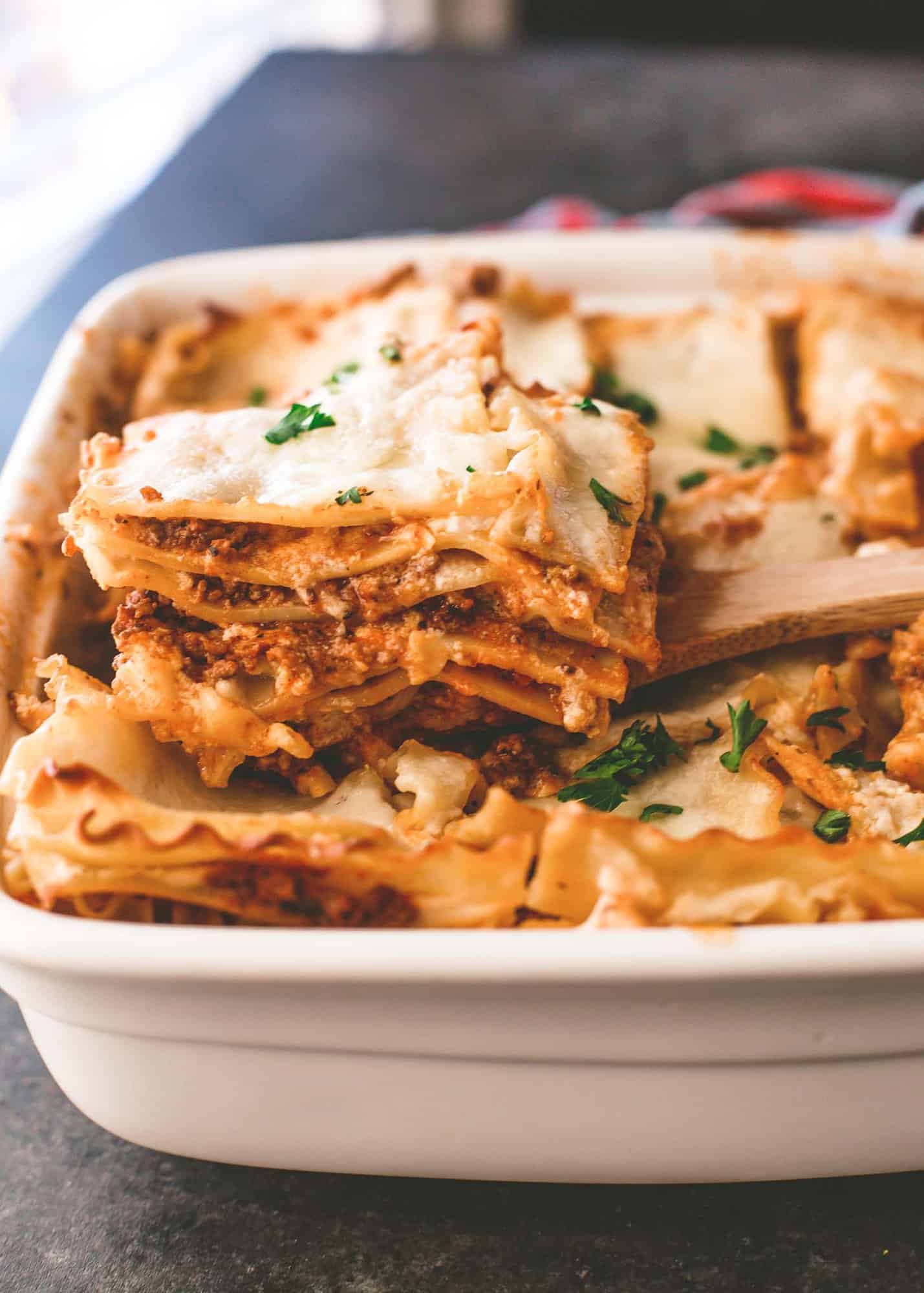
There’s no way around the fact that homemade lasagna is a bit of a project. But it’s also one of the most comforting and crowd-pleasing meals that you can make. Nothing makes the people around your table feel more cared for than a bubbly dish of homemade lasagna.
One of the things that makes some versions of lasagna expensive and heavy is the amount of cheese they contain. Enter lasagna bolognese. This is a lasagna with all of the flavor and creaminess we all love, without layer upon layer of cheese. Using a béchamel sauce (I promise – it’s simple to make!) in place of ricotta lets the the tangy tomato ragu shine, while also adding an incredibly creamy sauciness.
Add my all-time favorite Italian House Salad and super simple Garlic Bread Hawaiian Rolls on the side. If you’re going for the gold here, Ricotta Cake or Semolina Cake would be the perfect Italian-inspired desserts. If you’re looking for the ultimate guide on what to pair with lasagna, check out What to Serve with Lasagna for everything from wine pairings and apps to sides and desserts.
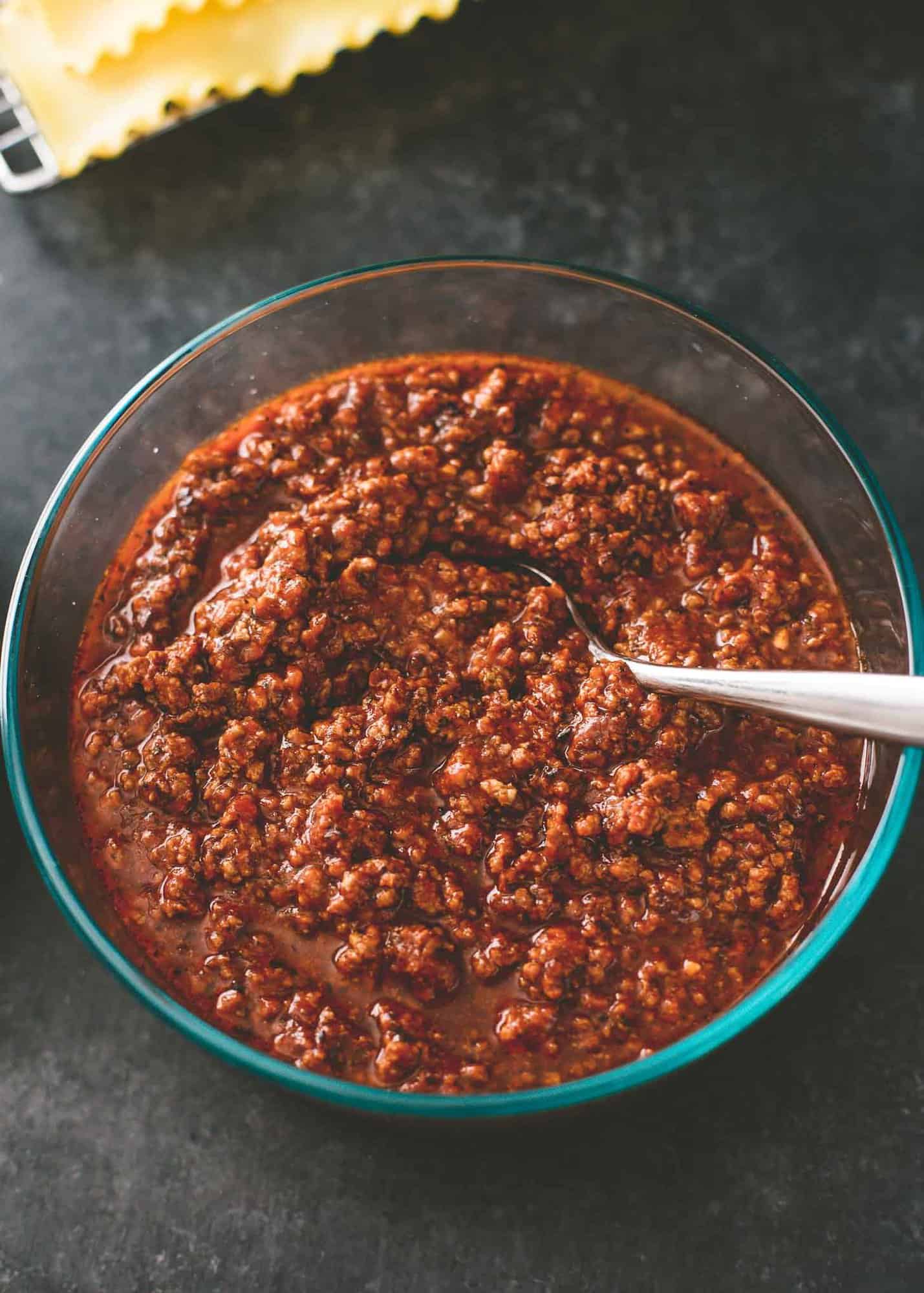
What is Lasagna Bolognese
Classic Italian Lasagna Bolognese consists of four parts – lasagna noodles, Bolognese ragu (a slow-simmered meat and tomato sauce), creamy béchamel (white sauce), and grated parmigiano-reggiano cheese. These are layered in a baking dish and baked to let all of the flavors come together.
How to Make It
Bolognese Ragu (below are stovetop instructions, but check out my Slow Cooker / Instant Pot Ragu for other options)
- Heat the oil in the skillet, and then cook the ground beef until it is nicely browned.
- Add the garlic, dried basil, dried oregano, water, and crushed tomatoes, and cook until the sauce begins to bubble.
- Reduce heat and gently simmer the sauce for 30 minutes to develop the flavors.
- When the sauce is ready, stir in the sugar, and season with salt and pepper to taste.
Bechamel
- In a large saucepan over medium heat, melt the butter, and then slowly whisk in the flour, whisking frequently to prevent the mixture from sticking to the pan.
- Add about a cup of milk when the sauce turns light golden brown, and continue whisking until thoroughly combined.
- Reduce heat to medium-low, and pour the remaining milk into the pan while whisking. The bechamel should become smooth and thick in about 10 minutes. Remember to keep the heat on medium-low. If the milk begins to boil, the béchamel will be gritty.
- Remove béchamel from heat and whisk in nutmeg. Taste and add salt if needed.
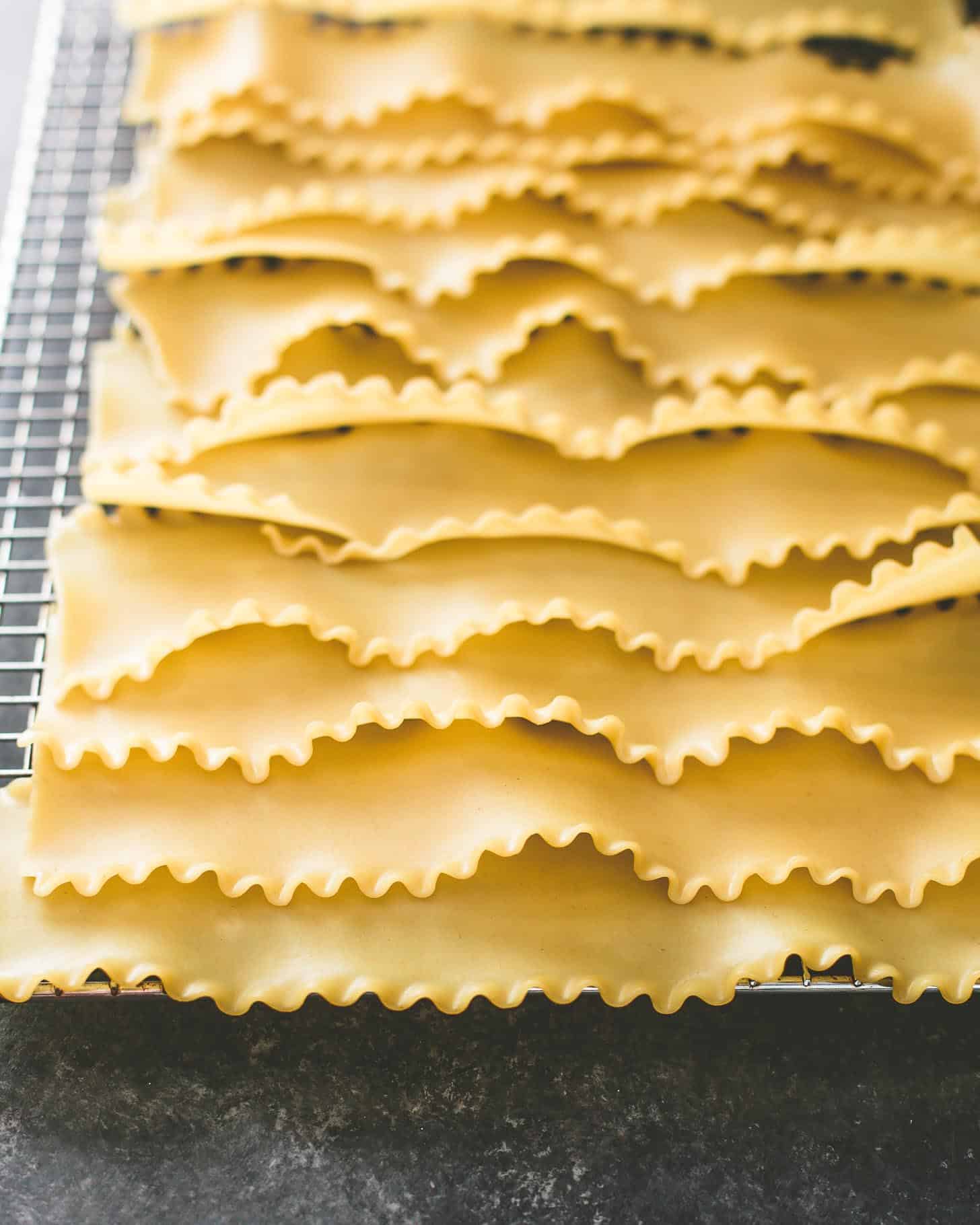
Boil the Noodles
- Boil noodles in a large stockpot of salted water. Boil according to package directions, and gently separate the noodles with a wooden spoon or spatula to prevent them sticking together.
- Drain noodles and lay flat in a single layer on a baking sheet or cooling rack.
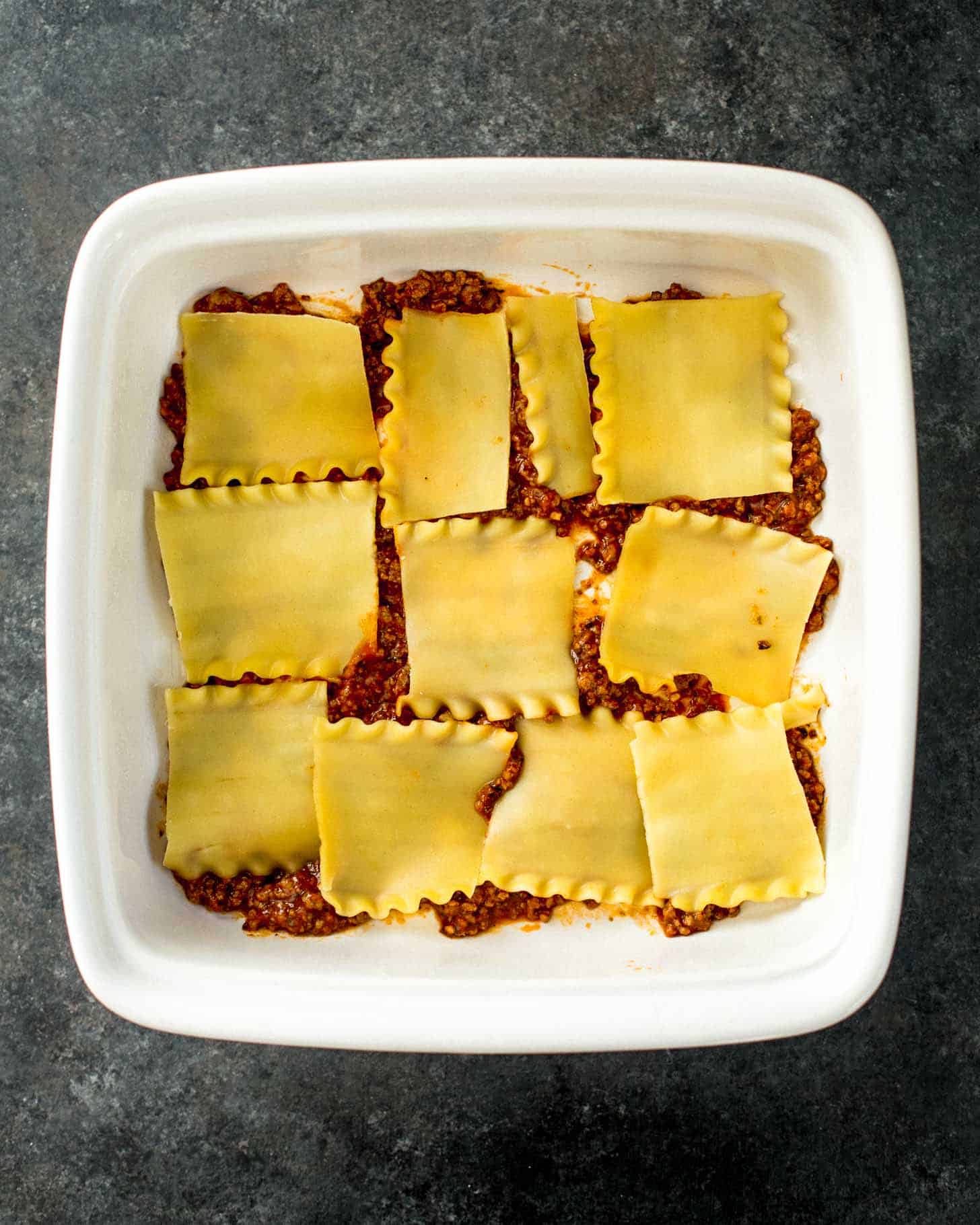
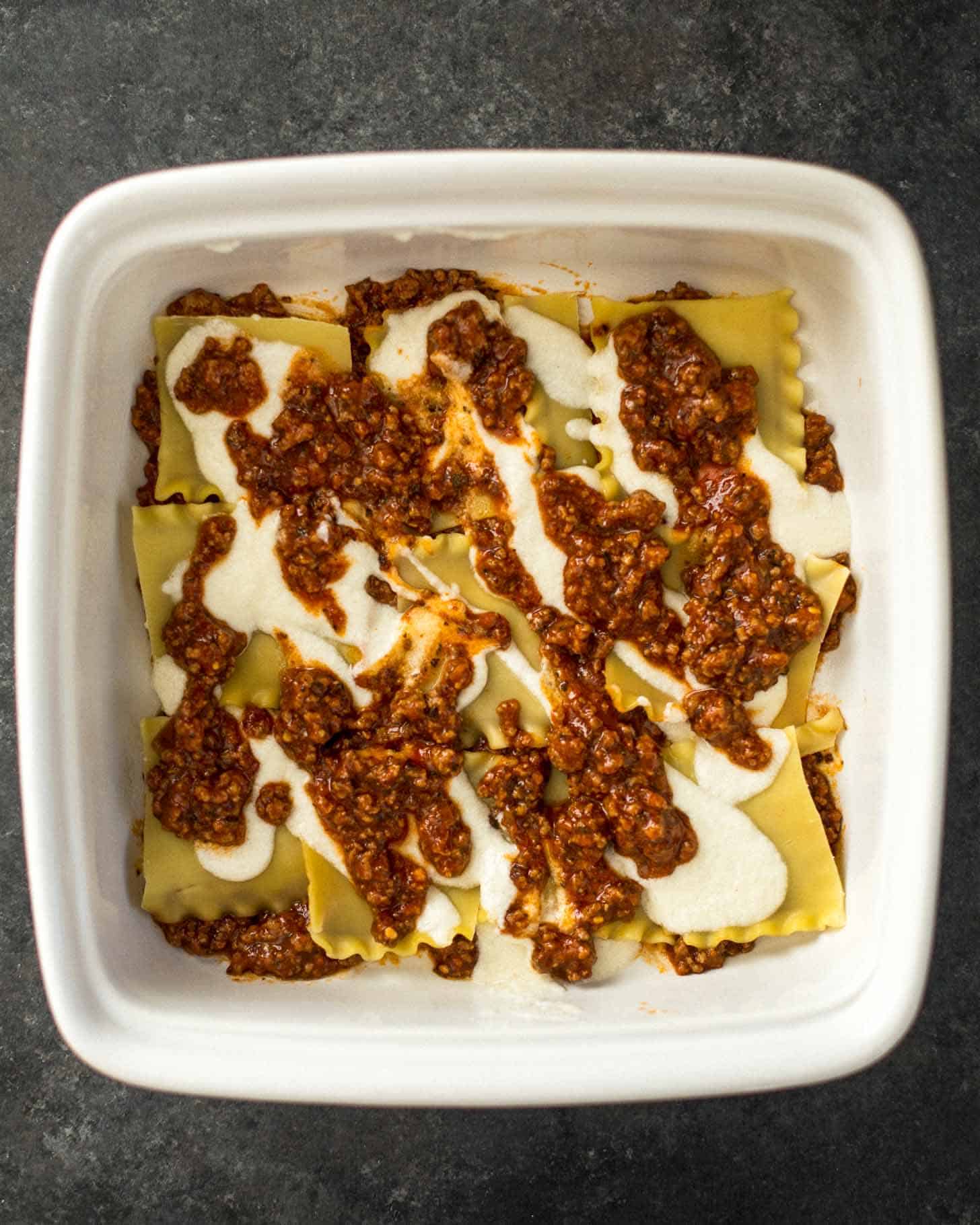
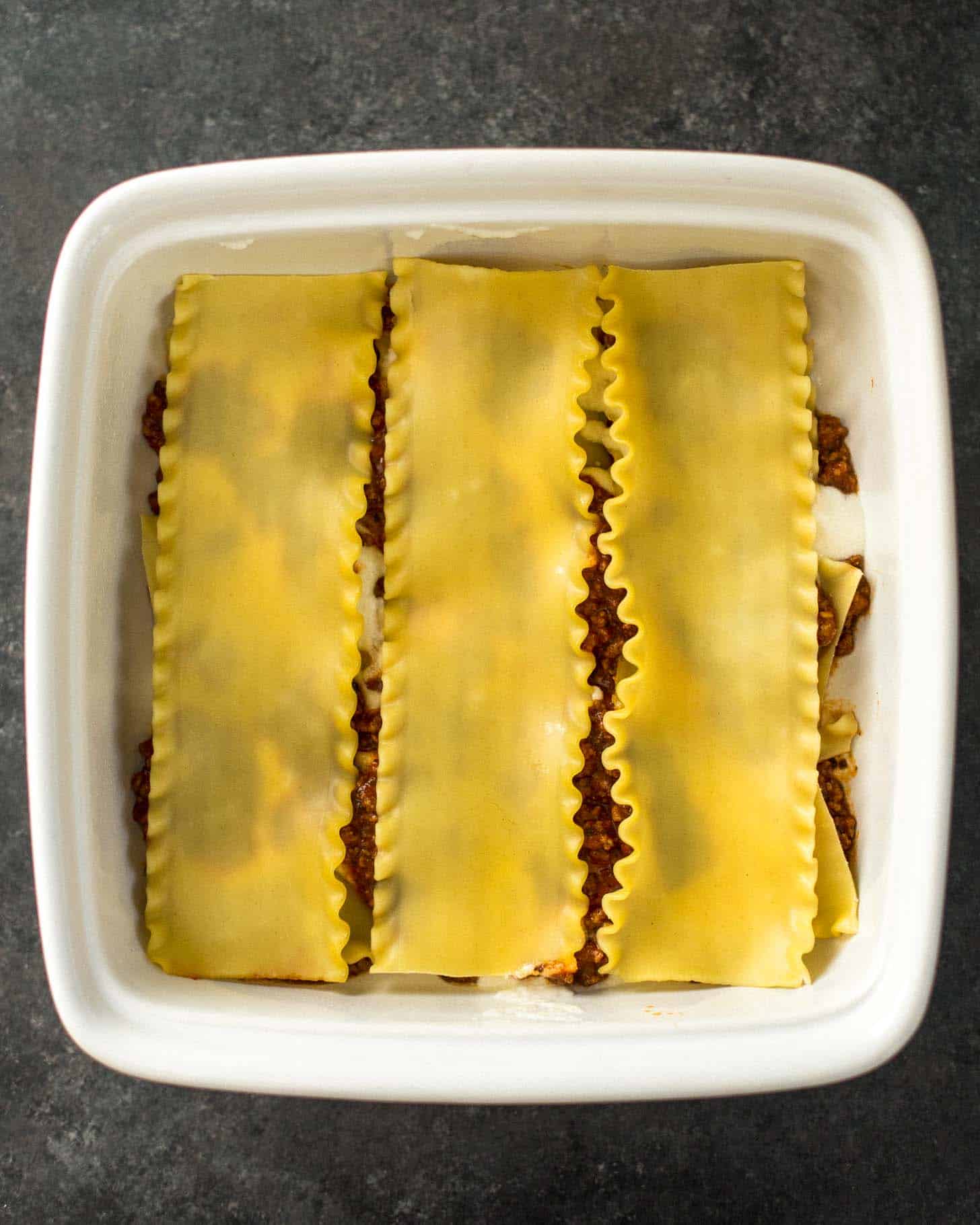
Ingredients
Ragu:
- Cooking Oil – Lasagna is an Italian dish, so you can’t go wrong with olive oil. You can also use grapeseed oil and avocado oil, which has a neutral flavor, is perfect for everyday cooking, and has a high smoke point which is great for browning ground beef.
- Ground Beef, Salt, Black Pepper – Adding a dash of salt and black pepper allows all of that meaty bolognese flavor to shine. Use a lean ground beef to avoid excess grease and fat in the pan – and in your lasagna!
- Garlic, Dried Basil, Dried Oregano – Lasagna wouldn’t be lasagna without this classic Italian trio. Herbs and garlic are magic in tomato sauces.
- Water – To maintain a “just right” consistency.
- Crushed Tomatoes, Sugar – Tomatoes can be pretty acidic. Using a touch of sugar to cut the acid results in a beautifully balanced tomato sauce.
Béchamel
- Butter, All-Purpose Flour – The two building blocks of béchamel. Butter gives you a rich base, and flour thickens things up.
- Milk – When making sauces, it’s always a good idea to use whole milk because it has such a creamy texture. 2% would also work in a pinch, just avoid skim and 1% milk. These lower fat milks will not provide the same richness as a full fat milk.
- Nutmeg – This common kitchen spice gives creamy béchamel just the right amount of warmth.
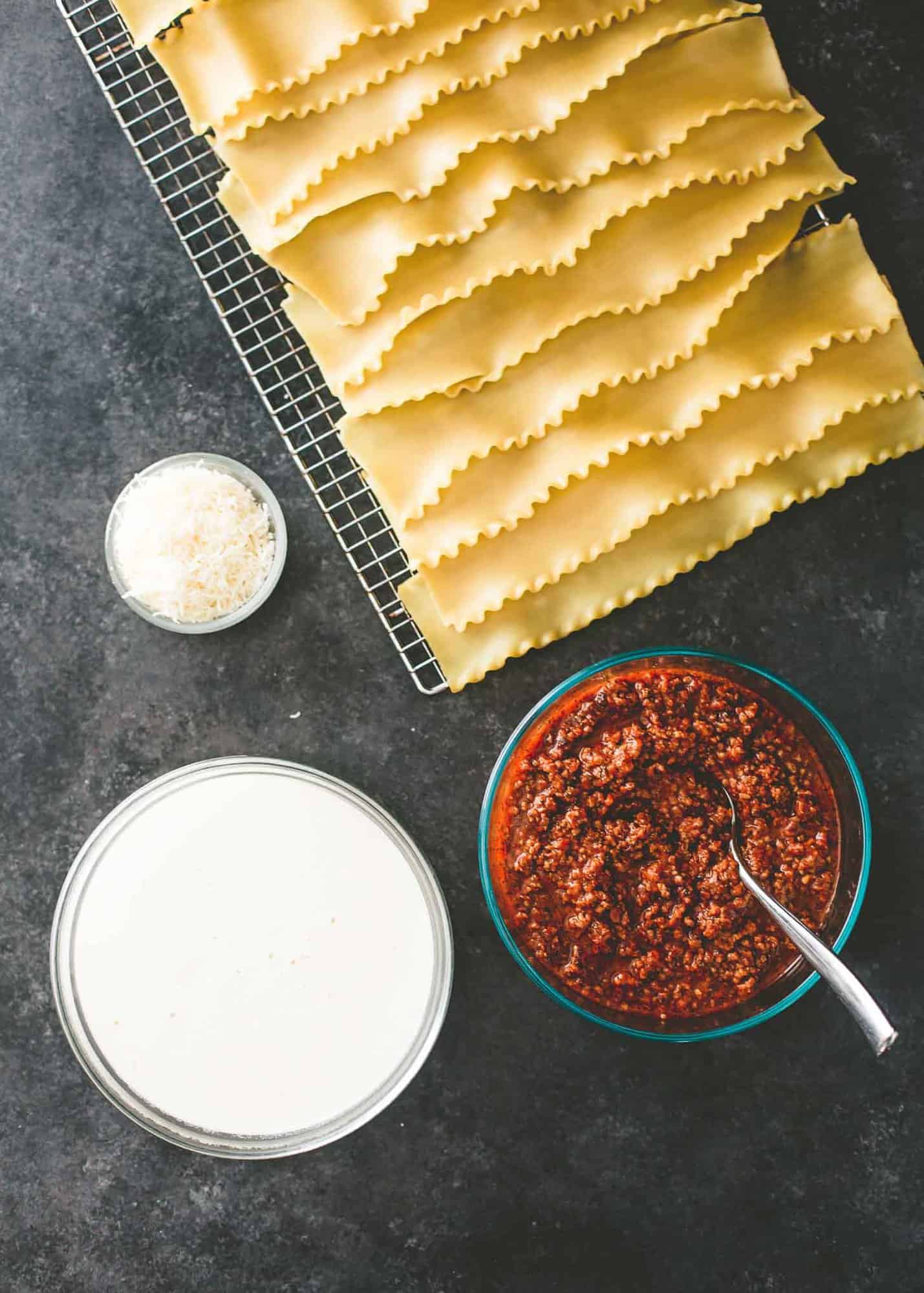
Lasagna Assembly
- Dried Lasagna Noodles – The building blocks of lasagna. While you can use no-boil noodles, we’ve found that they don’t provide the same texture as traditional dried noodles. You’re also depriving yourself of the classic, curly noodle edges that are universally loved by both kids and adults.
- Parmigiano-Reggiano – The one and only cheese in this easy Italian recipe. The distinct, sharp flavor of Parmigiano-Reggiano is all the cheese you need here.
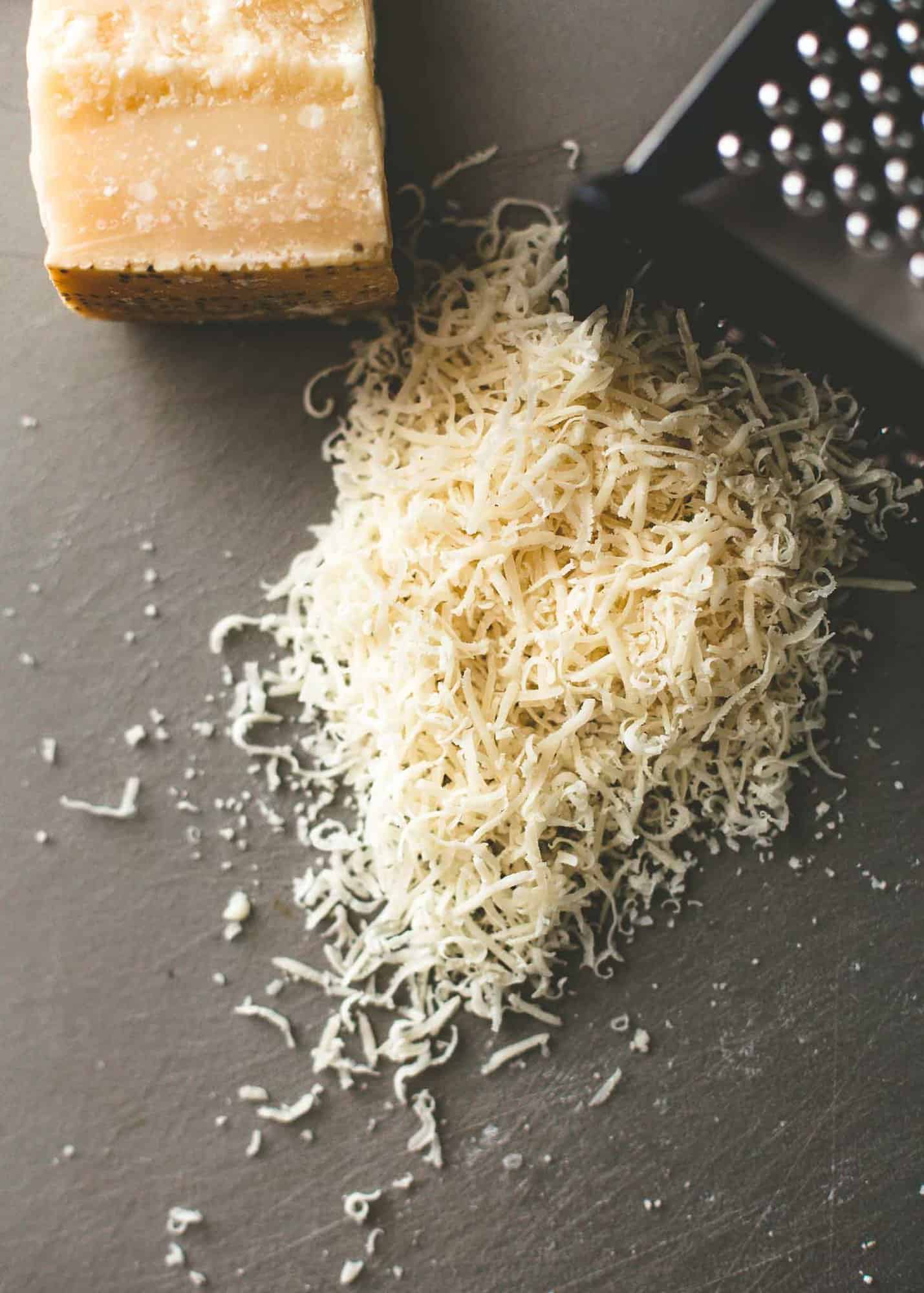
Variations
- Add Veggies – Lasagnas, and pastas in general, make it easy to sneak in iron-rich spinach, sautéed mushrooms, or bell peppers for extra flavor, texture and nutrients.
- Add some heat – Red pepper flakes work so well in tomato sauces, and give just the right amount of heat to put a little zing in each bite.
What is Béchamel?
Béchamel sauce is a creamy white sauce made from butter, flour, and milk, and it’s the secret ingredient in this lasagna bolognese. Don’t let that fancy French word throw you off because béchamel is super easy to make. This thick, nutty sauce adds depth to recipes like homemade mac and cheese, croque monsieur sandwiches, and, of course, lasagna!
Béchamel combined with parmesan cheese is all you need. Skip the ricotta! We love the savory-creamy flavor of these combined ingredients in lasagna, especially when it comes out of the oven bubbling hot and the parmesan cheese is golden brown and crispy around the edges.
Lasagna Bolognese is one type of real Italian lasagna that doesn’t include ricotta. However, this is a dish that has been adapted all over Italy and around the world, so there are many versions of lasagna that are made with ricotta (they just wouldn’t be considered Lasagna Bolognese).
Absolutely! Lasagna is one of the easiest dishes to make ahead of time and reheat. A lasagna’s sturdy structure allows it to hold up to a day or two in the fridge without collapsing, or letting all of those wonderful layers get mushy.
Need to save a little extra time in the kitchen? You can make the bolognese sauce up to 4 days in advance, the béchamel 2 days in advance, and, as for the noodles, they can be boiled 5 hours ahead – just be sure you leave them at room temperature.
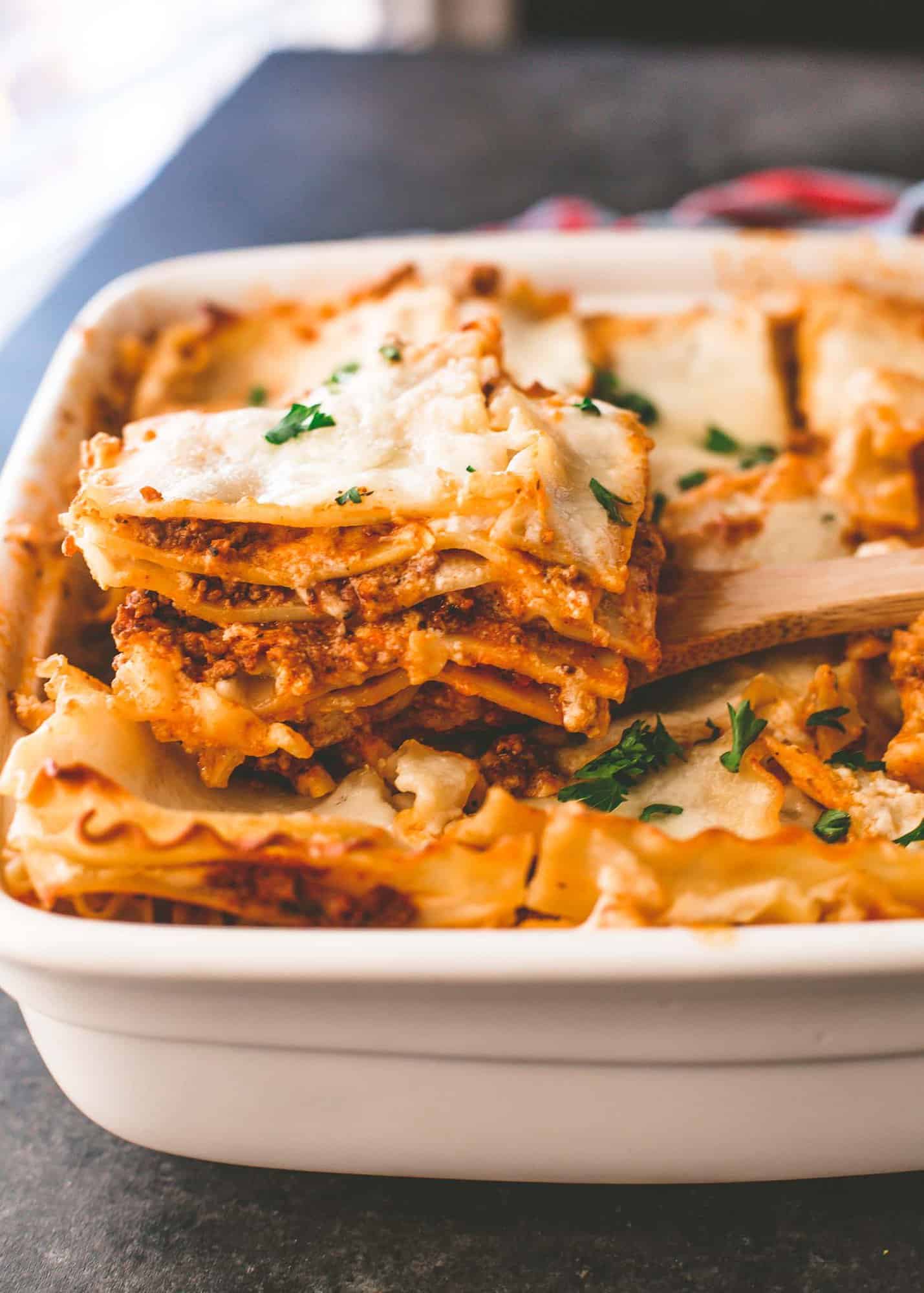
Tips for Freezing and Reheating
Lasagna Bolognese is easy to freeze in individual or family-sized portions, and a cinch to reheat. To reheat lasagna that has already been baked, first let the lasagna thaw in the fridge the night before, and then reheat the next day at 325°F for about an hour.
If you’re in a jam and need to reheat the lasagna right from the freezer, just plan on increasing the time by about 45 minutes to an hour.
Storing, freezing and reheating an unbaked lasagna is just as easy. Simply assemble, cover tightly with foil and refrigerate for up to 3 days, or freeze for up to 4 months. When you are ready to cook, remove from the freezer the night before, and follow the same baking instructions.
Print and attach the label below so that cooking instructions are right at your fingertips.
Favorite Tools
- 9×13 Baking Dish
- Large Skillet or Dutch Oven
- Large Saucepan
- Whisk
- Cuisinart Stockpot
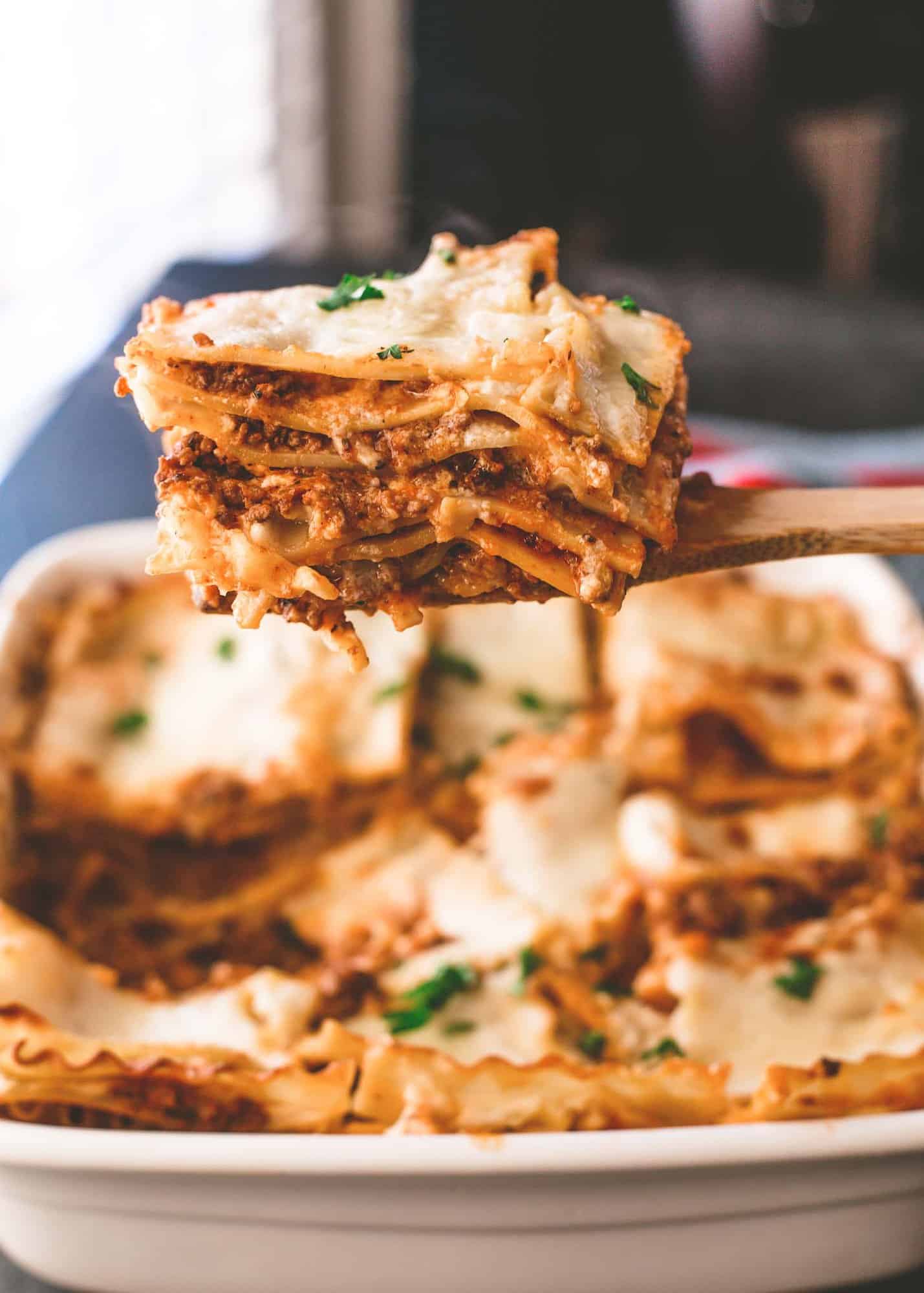
Pin this now to save it for later
Pin It Now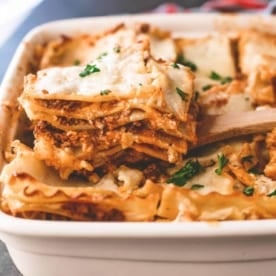
Lasagna Bolognese Recipe
Equipment
- 9 x 13 Baking Dish
- Stockpot
- Large Skillet or Dutch Oven
- Large Saucepan
- Whisk
Ingredients
Ragu
- 1 tablespoon cooking oil (olive oil works great; I use grapeseed oil or avocado oil for most everyday cooking)
- 1 1/2 pounds ground beef (93% lean)
- 1/2 teaspoon salt
- 1/4 teaspoon black pepper
- 4 cloves garlic, chopped
- 1 tablespoon dried basil
- 2 teaspoon dried oregano
- 1/2 cup water
- 1 28 ounce can crushed tomatoes
- 1 teaspoon sugar
Béchamel
- 4 tablespoons butter
- 1/4 cup all-purpose flour
- 3 1/2 cups milk, divided (preferably whole milk for a richer flavor and creamy texture, but 2% will work)
- Pinch ground nutmeg
Lasagna Assembly
- 1 pound dried lasagna noodles
- 4 ounces parmigiano-reggiano, finely grated
Instructions
Make the ragu
- Heat oil in a large heavy-bottomed skillet or Dutch oven over medium heat. (Note: if you are going to cook the entire sauce on the stovetop, be sure to use a pot that will hold all of the ingredients.)
- When oil is hot, add beef, salt, and pepper.
- Cook beef, breaking it apart with a spoon or spatula, until cooked through, 8 to 12 minutes.
- Add garlic, dried basil, dried oregano, water, and crushed tomatoes. Stir well.
- Let sauce cook until it begins to bubble, 5 to 6 minutes.
- Reduce heat so that the sauce is barely simmering and give it another good stir.
- Place a lid on the pot and let it simmer gently for 30 minutes to let the flavors develop.
- Check the sauce occasionally to be sure it isn’t burning on the bottom and to reduce the heat if needed.
- Stir sugar into the finished sauce. Taste and season the sauce with some salt and pepper or a bit more sugar, if needed until it tastes balanced.
Make the béchamel
- Melt butter in a large saucepan over medium heat. When butter is melted whisk in flour and cook, whisking frequently (and checking to be sure that none of it browns or burns on the bottom of the pan), until the mixture turns light golden brown, 3 to 4 minutes.
- Add about 1 cup of milk (just eyeball it) while whisking vigorously. Keep whisking until the milk heats up and everything is evenly combined. Slowly pour the remaining milk into the pan while whisking. Reduce heat to medium-low and continue cooking everything until the mixture thickens and becomes a smooth, creamy sauce, about 10 minutes. (Note: Resist the urge to turn up the heat and speed things along. If the milk starts to boil it can make the béchamel gritty.)
- Remove béchamel from heat and whisk in nutmeg. If you used unsalted butter, whisk in ½ tsp of salt.
Boil the noodles
- Bring a large stockpot of salted water to a boil. When boiling, add lasagna noodles and boil according to package directions. As the noodles cook, use a wooden spoon or spatula to gently separate them so they don’t stick together while boiling.
- Drain noodles and lay flat in a single layer on a baking sheet or cooling rack.
Assemble and bake
- Heat the oven to 325°F.
- Spray a 9×13 baking dish (or a 9×9 baking dish with very tall sides) with nonstick cooking spray or rub it with some olive oil.
- Spread the bottom of the pan with a very thin layer of ragu (it should not fully cover the bottom). Add noodles, a drizzle of béchamel, a sprinkle of parmesan cheese, and another layer of ragu. Repeat the layers until you have used all of the ingredients. Finish the top layer with noodles, béchamel, and parmesan cheese.
- Cover the baking dish tightly with foil and place it on a rimmed baking sheet (just in case it bubbles over).
- Bake, covered, for 1 hour. (Note: If you are making a thicker lasagna in a 9×9 dish or if you baked your lasagna straight from the refrigerator, add 5 to 7 minues here to be sure it's piping hot all the way through.)
- After 1 hour, remove foil and increase oven’s heat to 400°F.
- Return lasagna to the oven and continue baking for 10 to 15 minutes to let the edges get crisp.
- Let the lasagna cool for 10 minutes before slicing and serving. (It’s much easier to slice and serve if it’s had a few minutes to cool.)
Notes
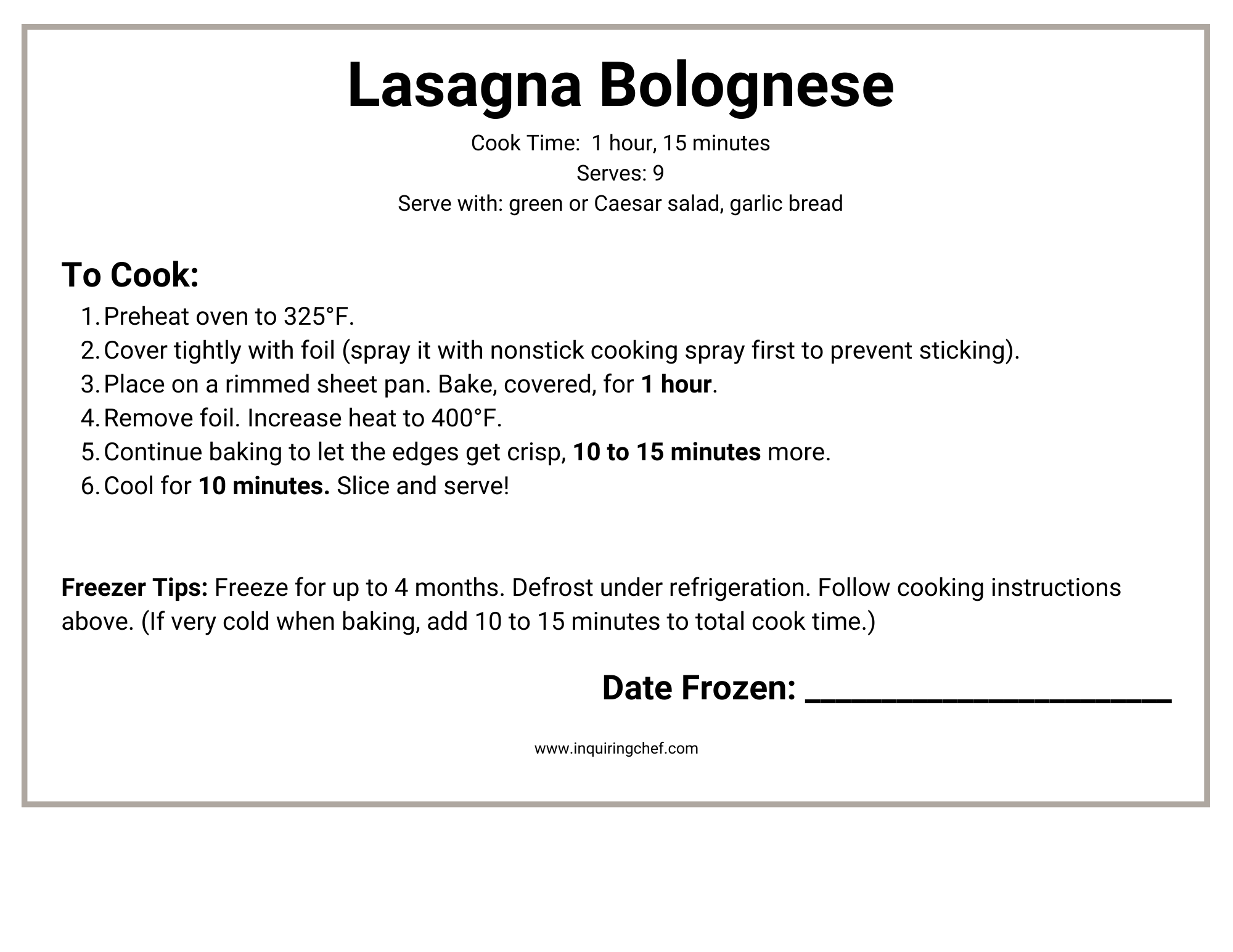
Nutrition
Nutrition information is automatically calculated, so should only be used as an approximation.
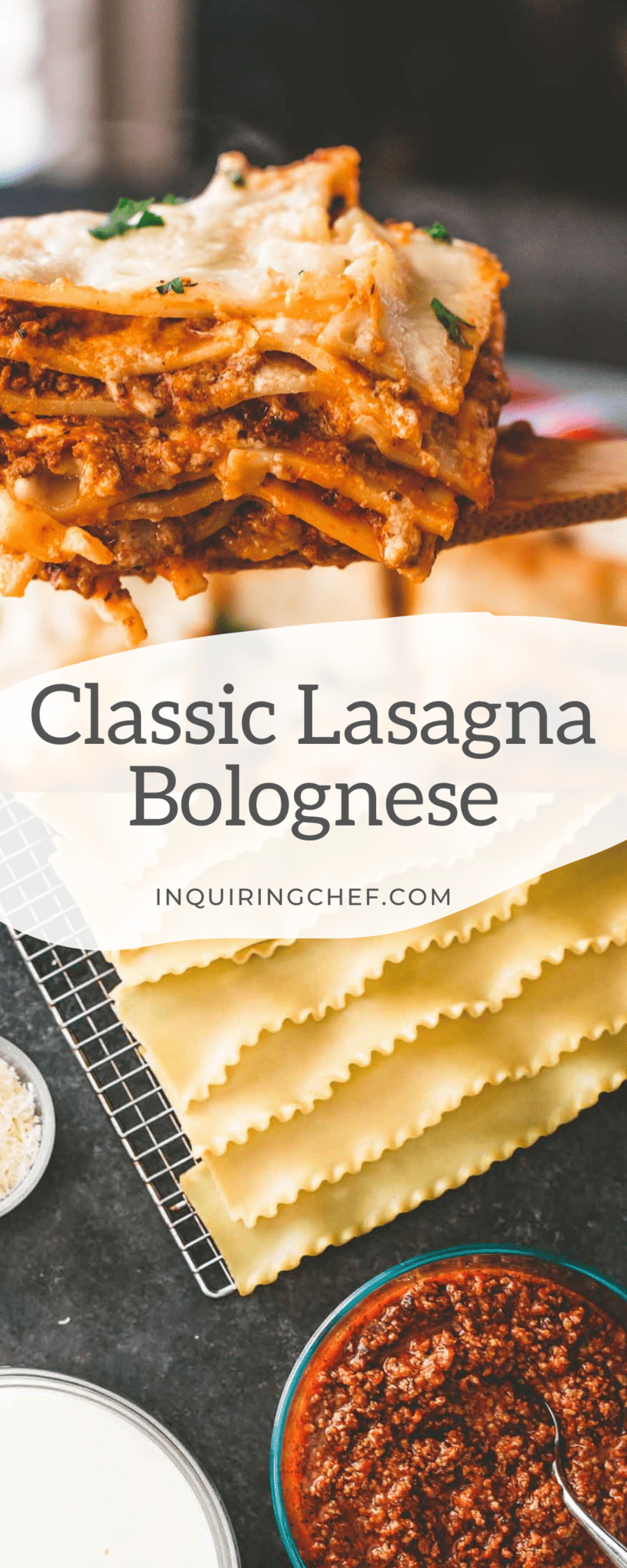
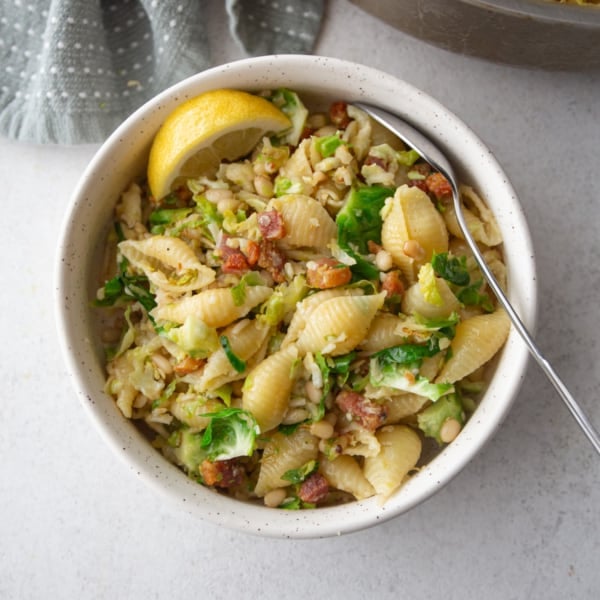
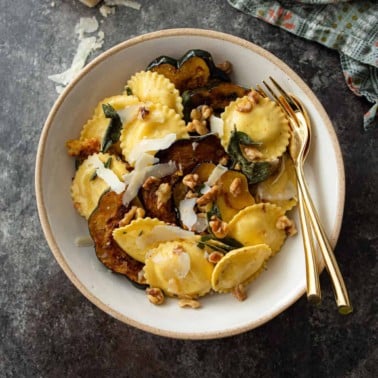










Do you ever make your Dad’s manicotti? It’s the best!!!
Never made it, but I often request it from him! 😉